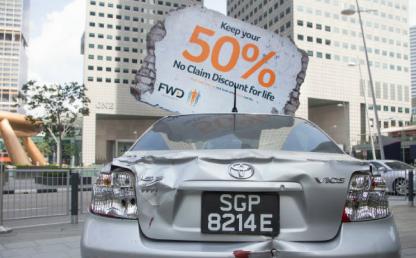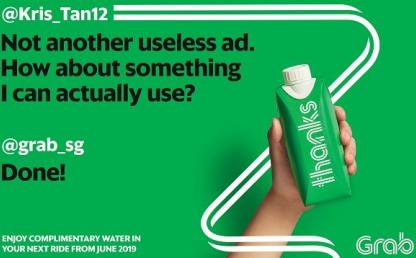Top 5 Experiential Charity Campaigns

This is the age of the Internet...but can everything be done online?
Marketers are actually increasingly turning to experiential marketing. It is able to offer personalization and connection, which are hard to achieve through online advertising. This is especially key for charities looking to expand their reach since they face an added obstacle: many feel indifferent in face of messages from charities. Without direct impact to our daily lives, the problems of the world can appear very far away.
Charitable organizations have gotten very creative in order to raise awareness. Many of the outstanding ones focus on experience: engaging the audience’s senses and perhaps invoking a collective memory. By doing this, organizations are able to bring the issue right to their audiences to establish a connection. Let’s take a look at some of our all-time favorites!
WaterAid Hope Locker (2016)
Cause: Water
The move to digital payment methods is convenient for many, but creates a new challenge for a lot of charities as they rely on cash donations. Charity WaterAid decided to incorporate technology and interaction to get cash donations from swimming pool locker rooms.
Why did they pick this location? They realized that locker rooms are one of the few places where coins are still used, and swimming pools made a lot of sense considering the charity’s mission of providing clean water access. So, they installed digital screens inside lockers that connected to the coin slots on the exterior. Once swimmers had gone back to the lockers to retrieve their belongings, the screen would show them jarring statistics on poor water quality or the lack of water access. The information was personalized to relate to the duration swum. Swimmers then had the choice to either get back their locker deposit or to donate it with a simple tap on the screen. It’s no surprise that many patrons chose to donate the coin. Each locker installed has the potential to generate £1,140 every year!
Unicef 27 Buses (2017)
Cause: Education
UNICEF wanted to bring attention to the 27 million out-of-school children living in conflict zones in the days leading up to the UN General Assembly in 2017. To bring the issue closer to home, UNICEF utilized an object that many New Yorkers associate with their education: yellow school buses. Partnering with UNICEF Goodwill Ambassador Muzoon Almellehan, who was forced to give up her education when she fled war-torn Syria, the organization mobilized 27 empty school buses symbolizing the 27 million children. This impressive yellow fleet drove through Brooklyn and Manhattan! Each carried an impactful message such as “avoiding landmines shouldn’t be an extracurricular activity”, and “tonight’s homework shouldn’t involve hiding”. In an added appeal to world leaders, light blue lunch boxes were left in public areas, addressed to certain leaders and containing a report on children’s education. This campaign sparked tremendous online conversation, press coverage, as well as donations.
WWF Stop Wildlife Trafficking (2018)
Cause: Wildlife
A hologram elephant roaming the streets of London surely isn’t a daily feat. It is bound to stop commuters in their tracks… and is exactly what WWF wanted in order to combat the “out of sight, out of mind” mentality when it comes to the illegal trafficking of endangered species. Not only was London able to see a majestic 5-meter elephant hologram, but also pedestrian crossings decorated with animal prints and shocking facts about wildlife trafficking. This stunt generated a lot of buzz with a second run in Edinburgh. And, it was able to help WWF gather enough signatures for their petition ahead of the Illegal Wildlife Trade Conference, where world leaders discussed the issue of wildlife crime.
Amnesty International Glass Box (2018)
Cause: Refugees
In anticipation of the Refugee Family Reunion Bill reading, Amnesty International UK wanted to give the Bill an extra boost in publicity. So, they turned family life into an art installation in this unprecedented campaign. Amnesty set up big glass boxes on London’s Southbank, where real families were brought in to spend family time. Some of them watched TV, others played board games...surrounded by hundreds of onlookers curious as to why ordinary life was on display. The audience would soon realize that the installation was meant to show us how life’s small moments spent with family are often taken for granted. By separating refugee children from their families, we would be denying them these precious memories. As a result, more than 13,000 people emailed their MP asking them to show up for the voting, with others expressing their support on social media using the hashtag #familiestogether. Amnesty needed 100 MPs to vote in order for the bill to pass and were delighted to see an overwhelming 131 MPs voting in favor!
Caritas Give Warmth (2014)
Cause: Homelessness
It was the dead of winter in Vienna and an especially unpleasant one for homeless Austrians, as the city government had evicted hundreds of them from Vienna City Park, previously a hotspot for homeless people. Caritas hoped to raise awareness as many would struggle to find a roof over their head that winter. In a creative experiential move, the charity switched out fluorescent light tubes in bus stop ad shells for lamps that gave off heat. For a 1 euro donation, commuters could experience the warmth of the lamps for a few minutes, much like how their donation could help bring warmth to the homeless. Not only did this campaign result in physical warmth for some people, it also helped turn what Caritas called “social indifference” for issues plaguing the city into “social warmth”.
Use experiential marketing as a voice for the greater good.
Gone are the traditional charity advertisements with calls to action. Experiential campaigns that deliver beyond restricted media spaces will help drive a heartfelt message and great impact. Get in touch with us today to find out how we can devise a new marketing angle for your charity’s mission!
 Insights
Insights

